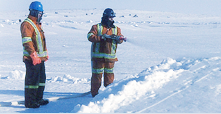Kennady Diamonds Drill Returns Average Sample Grade of 4.56Cts Per Tonne
December 17, 13
 |
The Kelvin summer drill program returned an average sample grade of 4.56 carats per tonne.
Kennady Diamonds CEO Patrick Evans commented: “2013 has been a remarkably successful year for Kennady Diamonds. Our two drill campaigns have produced results which far exceeded our expectations. We recovered a total of 4.3 tonnes of kimberlite from Kelvin containing more than 16,000 microdiamonds of which 474 are commercial size diamonds.
“The Kelvin summer drill program returned an outstanding sample grade of 4.56 carats per tonne and the winter program returned an exceptional sample grade of 8.13 carats per tonne, for a combined sample grade of 5.38 carats per tonne. These are amongst the highest kimberlite sample grades ever recorded and confirm that the Kelvin kimberlite has both a coarse diamond size distribution as well as the potential to host a high grade diamond resource”.
A total of 362 commercial size diamonds were extracted from 3,314 kilograms of kimberlite from the Kelvin summer drill program. By comparison, 112 commercial size diamonds were recovered from approximately 1,000 kilograms from the Kelvin 2013 winter drill program. This illustrates a high degree of consistency between the summer and winter samples of approximately one commercial size diamond for every nine kilograms of kimberlite.
Patrick Evans added: “In addition to the outstanding sample grade, it is very encouraging to see the presence of a number of high quality macro diamonds without any inclusions. Together with grade, diamond quality is a key value driver.”
The firm’s 2014 winter program is expected to be completed by May with the results being announced in the third quarter of 2014. The company plans to publish an initial resource statement for the Kennady North project during the fourth quarter of 2014.
The Kennady North project comprises 13 leases and claims located immediately to the north and west of the four leases controlled by the Gahcho Kué joint venture between De Beers Canada (51 percent) and Mountain Province (49 percent) located in Canada’s Northwest Territories.